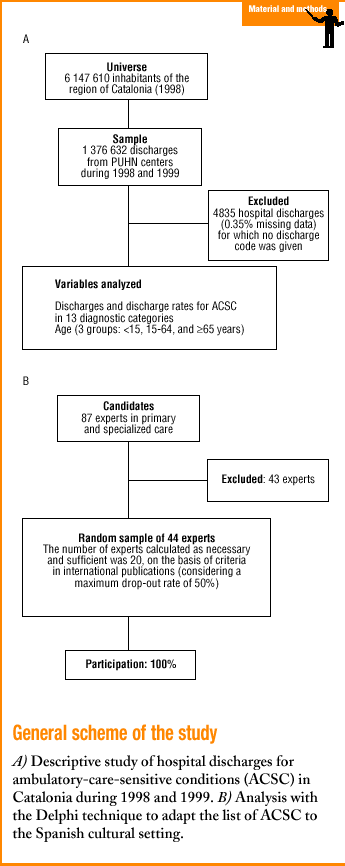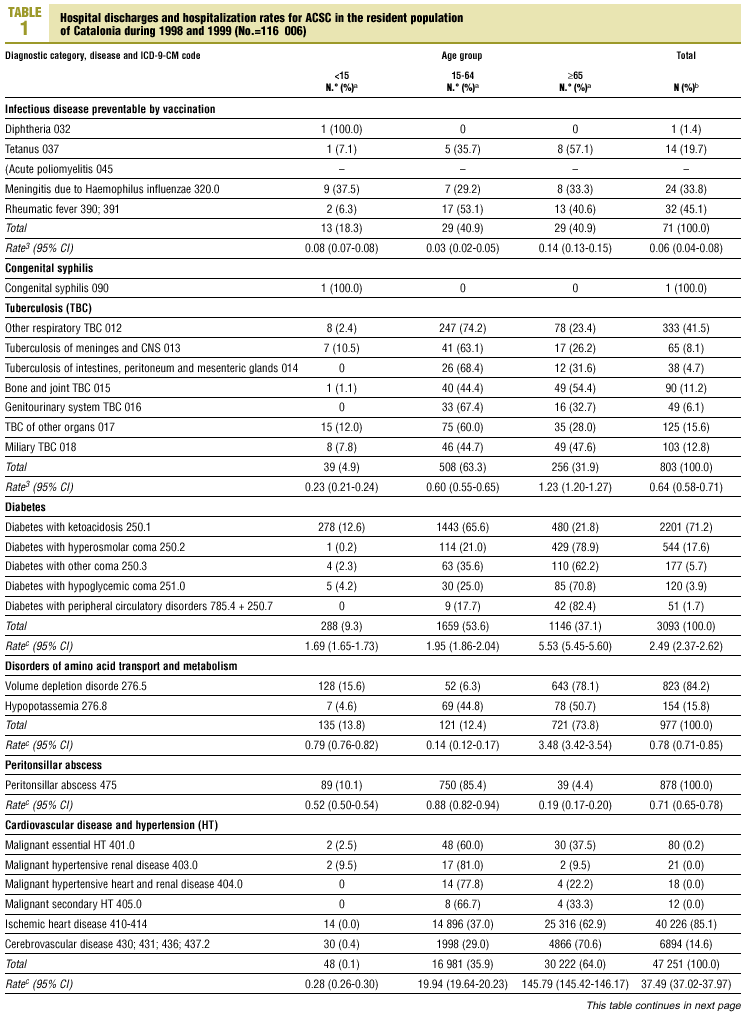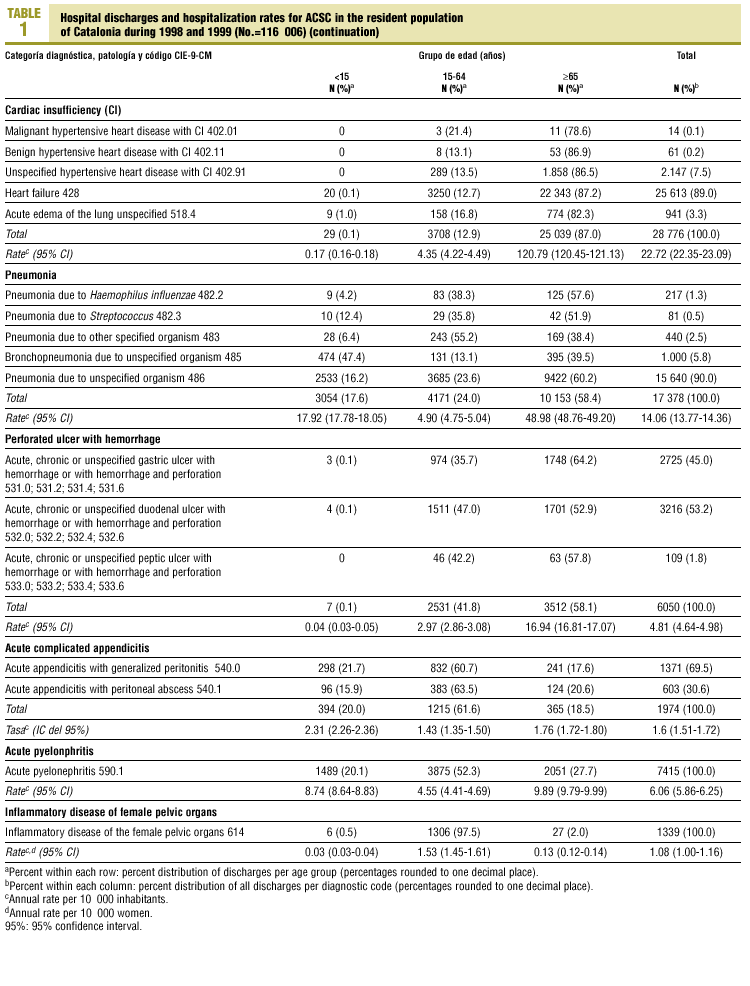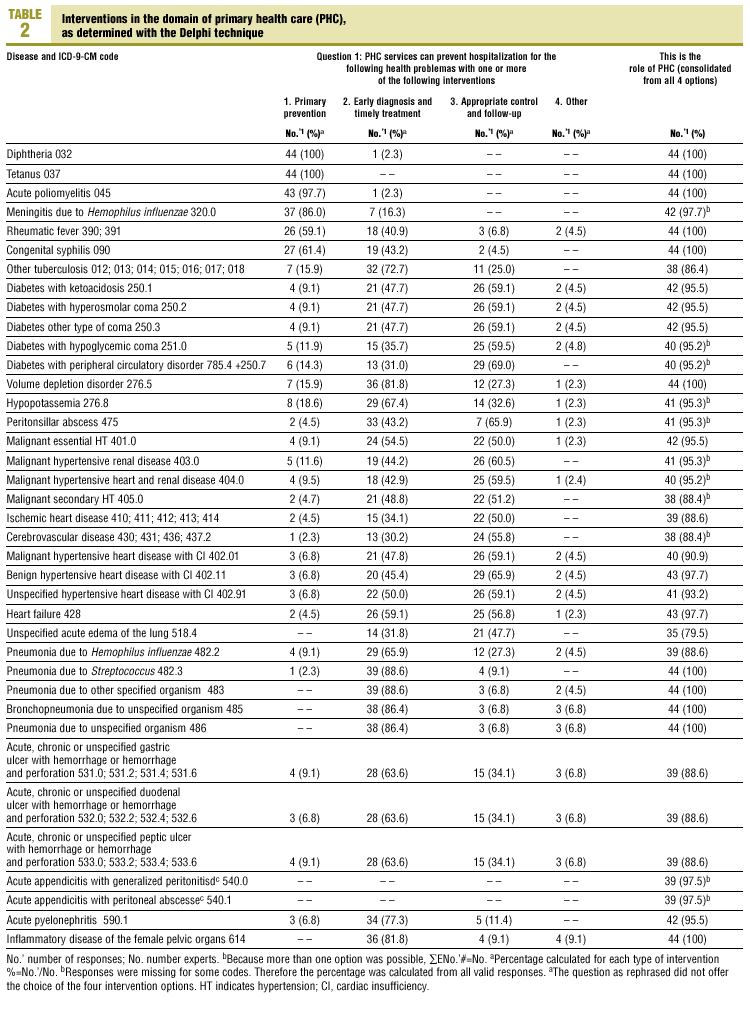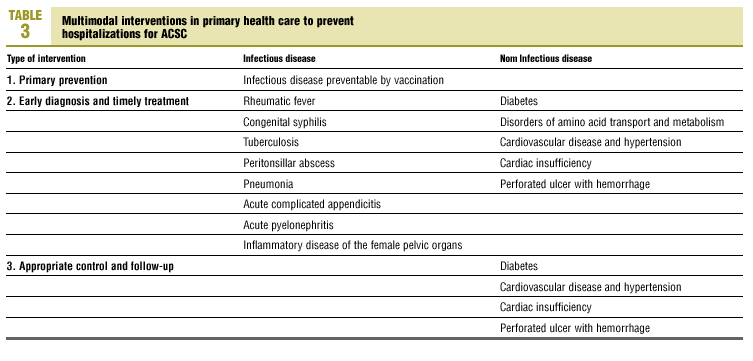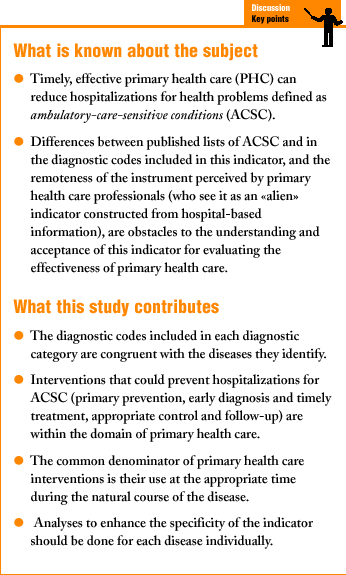Introduction
The development of evaluation systems that facilitate monitoring and comparisons of primary health care (PHC) services at a reasonable cost should be one of the aims of all health systems. Thus far, most studies of the evaluation of PHC services have set out to validate this level of care as a key element in an effective, efficient health system,1-4 and have been of great use in consolidating the health care reforms instituted in recent years.5,6 However, most of these global evaluations do not always provide practical information regarding how to improve and increase the quality of available interventions and their capacity to deal appropriately and effectively with the patient´s problem. The complexity of the design of indicators for measuring multiple, diversified activities7,8 and the lack of information from systematic studies of PHC systems that might be used to construct such indicators are two limitations that have curtailed the development of such evaluation systems thus far.
Despite these difficulties, recent studies have achieved progress in the design of indicators of the ability of PHC to deal with health problems by using secondary databases that make it possible to obtain precise information on the performance of this level of care. Hospitalizations for ambulatory-care-sensitive conditions (ACSC) are one such indicator. These conditions comprise a group of diagnostic codes for hospital discharges that have been proposed as an indirect indicator to measure the ability of PHC centers to deal effectively with the patient´s problem, and as a direct indicator of the volume of hospital activity potentially preventable by timely, effective care provided at the primary level.9,10 Studies in the setting of the Spanish health care system have documented the usefulness of this indicator for evaluating certain elements of PHC.11 For example, an association has been shown between reducing hospitalization rates and increased access to pediatric care,12 and between the former and continuous care provided by reformed basic health areas.13
In approximately 15 years´ worth of ACSC studies, researchers have generated various lists of diagnostic codes for hospital discharges considered to arise from ACSC.14 The differences between items in published lists, the amount of information in the indicator, and PHC physicians´ perceived lack of control over indicators constructed with hospital-based information,15 make it necessary to revise the processes used to validate and disseminate these instruments.
The present study aims to contribute to the process of validation of the indicator designated hospitalizations for ACSC by fulfilling two objectives: a) describing which specific health problems are identified by different sets of diagnostic codes, and b) identifying PHC interventions that, on the basis of expert criteria, would reduce the number of hospitalization for ACSC.
Material and methods
Information to fulfil the two aims of the study was obtained from two separate studies, one centering on hospital discharges and the other designed to adapt the list of ACSC to the Spanish cultural setting.
The first was a descriptive study of 1 376 632 hospital discharges generated by the resident population of the region of Catalonia (6 147 610 inhabitants according to the 1998 census of the National Institute of Statistics). Patients were seen at hospitals comprising the Public Use Hospital Network during 1998 and 1999. We studied all discharges attributable to all first admissions and readmissions, but excluded discharges for which no diagnostic code was recorded (0.35% missing data). All discharges with a diagnostic code included in the list of ACSC considered markers of the effectiveness of PHC were included.14,16,17 This list was organized in 13 diagnostic categories, each comprising one or more diagnostic codes from the International Classification of Diseases, Ninth Revision, Clinical Modification (ICD-9-CM)18 (Tables 1 and 2).
Sources of information: the Minimum Basic Hospital Discharge Dataset of the Catalonian Health Service for the years 1998 and 1999, the demographic statistics database of the National Institute of Statistics for the years 1998 and 1999, and the ICD-9-CM.
The percent distribution of discharges under each diagnostic code was recorded for age group (<15, 15-64 and >=65 years) and for the entire sample. Percent distributions per age group were calculated to reflect the distribution, in different population groups, of each diagnostic code (percent per age group across rows in the tables). Percent values for the entire sample were calculated to compare the distribution of diagnostic codes in each diagnostic category (percent of the total for each category in each column). Yearly hospitalization rates were calculated per 10 000 inhabitants, per age group and per diagnostic category, all with 95% confidence intervals.
The second study was designed to adapt the list of ACSC to the Spanish cultural setting. This was done by consensus with the Delphi technique, and yielded information on interventions considered high priority for PHC centers.14 A self-administered questionnaire inquired about two of the most relevant aspects used to determine whether hospitalization for a given ACSC was preventable by appropriate primary care:16,17a) whether prevention, control and follow-up of health problems generated by ACSC was within the domain of primary care, and b) whether hospitalization was necessary for a given ACSC once the health care problem had arisen. This study reported here analyzed only the results for the first question (Table 2).
A total of 44 experts completed the questionnaire (57% in PHC centers and the remaining 43% in specialized (secondary) care or management, planning and research at health centers). The acceptable level of consensus was set at 75%, and three rounds were needed, which were completed by 95.5% of the participants. Descriptive statistics for interventions considered high priority for PHC centers were based on univariate analysis, and the Kappa test was used to evaluate agreement of the responses between the two groups of professionals.
Results
Of a total of 1 376 632 hospital discharges generated by the resident population of Catalonia during 1998 and 1999, 116 006 (8.42%) were for diagnostic codes considered ACSC. Four diagnostic categories accounted for 86.9% of the ACSC: cardiovascular disease and hypertension (40.7%), cardiac insufficiency (24.8%), pneumonia (15.0%) and acute pyelonephritis (6.4%). These diagnoses accounted respectively for 37.5, 22.7, 14.1 and 6.1 hospital discharges per 10 000. Of the remaining ACSC, 13.1% corresponded to eight low-frequency diseases (Table 1).
Health problems specifically considered ACSC (Table 1)
The list of ACSC contains 13 diagnostic categories, four with a single diagnostic code and nine comprising several codes. The former were congenital syphilis, peritonsillar abscess, acute pyelonephritis and inflammatory disease of the female pelvic organs. The number of cases varied: although only one discharge coded as congenital syphilis was recorded in two years, the other three health problems contributed 8.3% of all hospitalizations for ACSC.
Of the diagnostic categories that comprise more than one diagnostic code, two types can be distinguished: those that group together different health problems, and those that refer to a single disease or disorder but record different locations or forms of presentation of the health problem or causal agent. The former included the category preventable infectious disease. This category includes several diseases, all of which are preventable by vaccination (such as diphtheria, tetanus, poliomyelitis and meningitis due to Haemophilus influenzae) or by antibiotic treatment (such as rheumatic fever). In this group the number of cases (71) reported during the 2-year study period was low.
The other diagnostic categories, that designate a single health problem for which different diagnostic codes specify location or form of presentation, were tuberculosis, diabetes, disorders of amino acid transport and metabolism, cardiovascular disease and hypertension, cardiac insufficiency, ulcer with hemorrhage and acute complicated appendicitis. By way of example we describe below cardiovascular disease and hypertension, the most complex group. The category cardiovascular disease and hypertension contains a large amount of information centering on problems attributable to hypertension involving different organs of the cardiovascular system, among other known factors. For «ischemic heart disease» and «cerebrovascular disease» the codes specify the location involved, the mode of manifestation, or both. Thus «ischemic heart disease», which contributed 85.1% of all cases in this group, included «acute myocardial infarction» (ICD-9-CM: 410) in all presentations (ranging from anterolateral wall--code 410.1--to «unspecified site» -- code 410.9), and all «other acute and subacute forms of ischemic heart disease» (code 411), «old myocardial infarct» (code 412), «angina pectoris» (code 413) and «other forms of chronic ischemic heart disease» (code 414). As an example of the categories that contain codes which specify the causal agent, our list of ACSC contained the category pneumonia.
Analysis of the distribution of cases in different population groups revealed the diverse types of information the indicator provided. In other words, the indicator allowed us to identify health problems with high rates of occurrence (37.49 discharges per 10 000 inhabitants per year for cardiovascular disease and hypertension) along with infrequently occurring diseases (0.71 per 10 000 inhabitants per year for peritonsillar abscess). We also noted marked differences in distributions by age group. For example, 87.0% of all cases of cardiac insufficiency occurred in persons 65 years of age or more, 85.4% of all cases of peritonsillar abscess were recorded in the 15-to-64-year-old group, and nearly half (47.4%) of the cases of bronchopneumonia were recorded in residents younger than 15 years.
High-priority interventions for primary care centers to reduce the number of hospitalizations for ACSC (Table 2)
All health problems, whether acute or chronic, were considered sensitive to one or more interventions at the primary care level. In some cases a high-priority intervention could be readily identified, such as primary prevention through vaccination for a specific infectious disease. However, in most cases the experts agreed on the importance of multimodal interventions such as early diagnosis together with timely treatment, and adequate control of and follow-up for diabetes (Table 3).
The expert panel failed to identify any primary care intervention for the group of cardiovascular diseases because the initial definition of this group included hypertension as a selection criterion for cases, whereas hypertension was excluded from the lists of ACSC proposed at the conclusion of the process of transcultural adaptation of the instrument.14 Another relevant aspect of the process of compiling responses to the questionnaire was the difficulty in identifying which primary care intervention might prevent hospitalizations for acute complicated appendicitis. This disease made it necessary to rephrase the questionnaire item to clarify that the task of the primary care center was not to treat complicated appendicitis, but to reach a differential diagnosis between diffuse abdominal pain and early diagnosis of acute appendicitis. As a result no responses were obtained for this disease in any of the four options the questionnaire provided for primary care intervention (Table 2).14 Combining the information from the two studies allowed us to identify population groups for whom the suggested interventions should be considered high priority (Tables 1 and 2). For example, almost all cases of tetanus occurred in the population of persons older than 15 years, making this the target population for potential interventions aimed at improving primary care.
Discussion
The list of ACSC used in the present study was arrived at through a process of selection and transcultural adaptation which identified diagnostic codes valid for the evaluation of the effectiveness of PHC in Spain. This process enhanced the internal validity of the indicator by selecting diagnostic codes that minimized the limitations arising from the influence of the patients´ clinical characteristics or from variability in hospital clinical practices or admission policies.14 For example, tuberculosis includes tuberculosis of the meninges, miliary tuberculosis and genitourinary system tuberculosis among other complications of pulmonary tuberculosis (Table 1). Most of these cases resulted from postprimary, early or late hematogenous dissemination, or from direct progression of a subpleural focus of tuberculosis, which might have been prevented by early diagnosis and appropriate treatment of pulmonary tuberculosis.19 Pulmonary tuberculosis is not included in our list because we consider hospitalization unnecessary for most cases.
The variety of diseases included in the indicator makes it advisable to analyze each code individually to increase specificity. For example, interventions aimed at reducing hospitalizations for coma in patients with diabetes are completely different from interventions aimed at reducing hospitalizations for perforated bleeding ulcer. Nevertheless, not all diseases can be analyzed individually at the level of the basic health area, because of the low numbers of cases (<1/10 000 per year). However, the seriousness of these diseases, the role of PHC centers in controlling them, and the cost-effectiveness of health interventions8,20-22 justify their inclusion as diseases that can be used to trace the effectiveness of PHC. We therefore propose that initially, low-frequency diseases should be analyzed as a group to diagnose the overall ability of PHC centers to deal appropriately with these health problems. Then individual diseases can be identified as intervention strategies are established. By way of example, most of the 14 cases of tetanus (92.8%) occurred in the adult population, which suggests the need to promote and ensure systematic vaccination in this population group.23-26 Vaccination targeted specifically to this group should be considered a high priority in basic health areas where cases have been reported.
Regarding the ability of PHC centers to reduce this type of hospitalization, all diagnostic codes were considered sensitive to interventions at the primary care level, although the type of intervention and the potential volume of hospitalizations that might be prevented vary depending on the health problem. For example, primary prevention was considered fundamental for infectious diseases such as diphtheria (preventable by immunization), rheumatic fever (preventable by early diagnosis and treatment of the disease precursor), or inflammatory disease of the female pelvic organs (preventable by treating the disease in the initial stages of its course). For most such cases we would expect to prevent all hospitalizations except those for disadvantaged population groups for which health care is still in its incipient stages, ie, immigrants from developing countries. On the other hand, the most immediate foreseeable result for chronic diseases is not their elimination, but a decrease in acute and chronic complications27,28 or a reduction in hospital readmissions and mean lengths of stay (e.g., for cardiac insufficiency).29 The summary of activities proposed here reflects the importance of primary and secondary prevention as roles within the domain of PHC. The common denominator of these interventions is their timely use in accordance with the patient´s biological age (primary prevention), or the natural history of the disease (early diagnosis and appropriate treatment).
With regard to the limitations of the coding system, we note the internal consistency of the diagnostic categories as shown by the present findings. Because the goal of diagnostic categories is to ensure that all cases of a given disease are recorded accurately, we considered problems with the quality and definition of some diagnostic codes to be of secondary importance. Questions relating to the quality of the record and the need to develop a common coding language for all levels of care30 are challenges the health care system is now dealing with.
In conclusion, the diagnostic codes considered ACSC were congruent with the diseases they identify, and interventions that could reduce hospitalizations for ACSC are within the domain of the primary level of care. Both findings help support the validity of the indicator for measuring the effectiveness of primary health care.
Correspondence: Josefina Caminal Homar. Universitat Autònoma de Barcelona. Facultat de Medicina. Medicina Preventiva i Salut Pública. Edifici M. 08193 Bellaterra. Cerdanyola del Vallès (Barcelona). España. E-mail: josefina.caminal@uab.es
Partially supported by FIS projects 97/1112 and 00/0047.
Manuscript received 30 August 2002.
Manuscript accepted for publication 9 October 2002.





